Republic of the Congo facts for kids
Quick facts for kids
Republic of the Congo
|
|
|---|---|
|
|
|
|
Motto: "Unité, Travail, Progrès"
"Unity, Work, Progress" |
|
|
Anthem: "La Congolaise"
Besi Kôngo "The Congolese" |
|
| Capital and largest city
|
Brazzaville 4°16′S 15°17′E / 4.267°S 15.283°E |
| Official languages | French |
| Recognised national languages |
|
| Religion
(2020)
|
|
| Demonym(s) |
|
| Government | Unitary semi-presidential republic under a dominant-party authoritarian state |
| Denis Sassou Nguesso | |
| Anatole Collinet Makosso | |
| Legislature | Parliament |
| Senate | |
| National Assembly | |
| Independence | |
|
• Republic established
|
28 November 1958 |
|
• from France
|
15 August 1960 |
| Area | |
|
• Total
|
342,000 km2 (132,000 sq mi) (64th) |
|
• Water (%)
|
3.3 |
| Population | |
|
• 2023 estimate
|
6,228,784 (116th) |
|
• 2023 census
|
6,142,180 |
|
• Density
|
17.96/km2 (46.5/sq mi) |
| GDP (PPP) | 2023 estimate |
|
• Total
|
|
|
• Per capita
|
|
| GDP (nominal) | 2023 estimate |
|
• Total
|
|
|
• Per capita
|
|
| Gini (2011) | 40.2 medium |
| HDI (2022) | medium · 149th |
| Currency | Central African CFA franc (XAF) |
| Time zone | UTC+1 (WAT) |
| Date format | dd/mm/yyyy |
| Driving side | right |
| Calling code | +242 |
| ISO 3166 code | CG |
| Internet TLD | .cg |
The Republic of the Congo is a country in Africa. Its capital city is Brazzaville. The country used to be a colony of France. It became an independent nation on August 15, 1960.
The northern part of the country has huge areas of rainforest. In the south, there are many farms. Farmers there grow bananas, peanuts, and other crops.
Contents
History of the Republic of the Congo
Around 1500 BC, Bantu-speaking people moved into this region. They formed tribes and mostly replaced the earlier inhabitants, the Pygmy people. The Bakongo group, a Bantu ethnic group, lived in parts of what is now Angola, Gabon, and the Democratic Republic of the Congo.
By the 13th century, there were three main groups of states in the western Congo Basin. The Kongo, Loango, and Teke kingdoms built trade routes. These routes led into the Congo Basin.
The Portuguese explorer, Diogo Cão, reached the mouth of the Congo River in 1484. Trade grew between the local kingdoms and European merchants. They traded goods and people who were captured and enslaved. In the 19th century, European countries began to colonize the Congo River delta. This weakened the power of the Bantu societies.
The area north of the Congo River became French in 1880. This happened after Pierre de Brazza made a treaty with King Makoko of the Bateke people. This French colony was first called French Congo, then Middle Congo in 1903.
In 1908, France created French Equatorial Africa (AEF). This included Middle Congo, Gabon, Chad, and Oubangui-Chari (which is now the Central African Republic). France made Brazzaville the capital of this larger area. For the first 50 years, the economy focused on taking natural resources. Building the Congo–Ocean Railway after World War I was very difficult. It is thought that at least 14,000 lives were lost.
During World War II, Brazzaville was a key place for Free France. It was their symbolic capital from 1940 to 1943. The Brazzaville Conference of 1944 led to changes in French colonial policy. Congo benefited from more money for administration and infrastructure. This was because of its central location and Brazzaville being the capital.
In 1958, the French constitution changed. French Equatorial Africa split into separate parts. Each part became an independent colony within the French Community. Middle Congo became the Republic of the Congo in 1958. It wrote its first constitution in 1959. There were some riots in Brazzaville in February 1959. The French Army stopped them.
Elections happened in April 1959. The Congo became independent in August 1960. Fulbert Youlou became the first President of the Republic of the Congo. He was against communism. Because of political tension, Youlou moved the capital to Brazzaville.
The Republic of the Congo became fully independent from France on August 15, 1960. From 1969 to 1992, it was a Marxist–Leninist state. It was called the People's Republic of the Congo (PRC). Since 1992, the country has had elections with multiple political parties. However, a government elected by the people was removed in the 1997 civil war. President Denis Sassou Nguesso first came to power in 1979. He ruled until 1992 and then again after 1997.
Geography and Climate
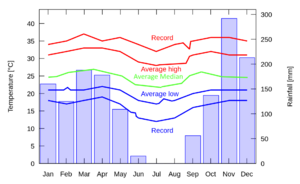
The Republic of the Congo is in the central-western part of sub-Saharan Africa. It is located along the Equator. To its south and east is the Democratic Republic of the Congo. It also shares borders with Gabon to the west, Cameroon and the Central African Republic to the north, and Cabinda (part of Angola) to the southwest. It also has a coast on the Atlantic Ocean.
The country has many different natural areas. These include savanna plains, flooded forests, the Congo River, and rugged mountains. There are also 170 kilometers of beaches along the Atlantic coast.
Because Congo is on the Equator, its climate is warm and humid all year. The average daytime temperature is about 24°C (75°F). Nights are usually between 16°C (61°F) and 21°C (70°F). The amount of rain changes across the country. It can be from 1100 mm (43 inches) in the south to over 2000 mm (79 inches) in central areas. The dry season is from June to August. The wet season has two main rainy periods: one from March to May and another from September to November.
Amazing Wildlife
The Republic of the Congo is home to about 10,000 types of tropical plants. About 3,000 of these are found only in Congo. The country has very diverse and rich environments. It also has some of the largest forest areas in Africa. Only the Democratic Republic of the Congo has more plant types.
Researchers have studied gorillas in the forests around the Ouesso district. They believe there are about 125,000 western lowland gorillas living there. These gorillas have been mostly safe from humans because of the difficult-to-reach swamps.
Government and Administration
The Republic of the Congo has a semi-presidential system of government. This means there is an elected president who chooses the Council of Ministers, also called the Cabinet. The Prime Minister and other ministers are chosen from elected representatives in Parliament.
Since the 1990s, the country has had a system with multiple political parties. However, President Denis Sassou Nguesso and his party, the Congolese Labour Party, have been in power for a long time.
In 2015, President Sassou Nguesso announced a vote to change the country's constitution. This change would allow him to run for president for a third time. The government said that 92% of voters approved the change. However, opposition groups disagreed. They said the vote was not fair. There were protests and some people were killed by security forces.
How the Country is Divided
The Republic of the Congo is divided into 12 main areas called départements (departments). These departments are then split into smaller areas called communes and districts.
The 12 departments are:
- Bouenza
- Brazzaville
- Cuvette
- Cuvette-Ouest
- Kouilou
- Lékoumou
- Likouala
- Niari
- Plateaux
- Pointe-Noire
- Pool
- Sangha
Economy
The economy of the Republic of the Congo is a mix of different things. There is farming and handicrafts in villages. There is also an industrial sector, which mainly focuses on petroleum (oil). The government faces challenges with its budget.
Oil extraction has become the most important part of the economy. In 2008, the oil sector made up 65% of the country's GDP (Gross Domestic Product). It also brought in 85% of the government's money and accounted for 92% of all exports. The country also has many minerals that have not yet been dug up.
In the 1980s, more money from oil helped the government pay for big development projects. The country's GDP grew by about 5% each year. However, the government also borrowed money against its future oil earnings. This led to a shortage of money later on.
The country has tried to improve its economy with help from groups like the World Bank and the International Monetary Fund. But these efforts stopped in 1997 when a civil war started. When President Sassou Nguesso returned to power, he wanted to continue economic reforms.
The country still faces challenges in helping its economy grow and reducing poverty. Oil prices have been high since 2003, which helps. Natural gas and diamonds are also exported. The Republic of the Congo joined the Organization of Petroleum Exporting Countries (OPEC) in 2018.
The Congo–Ocean Railway was built by forced laborers in the 1930s. Some old buildings from the colonial time are still there. For example, the Basilica of Sainte-Anne du Congo in Brazzaville was finished being restored in 2011.
People and Culture
| Year | Million |
|---|---|
| 1950 | 0.8 |
| 2000 | 3.2 |
| 2018 | 5.2 |
Most of the people in the Republic of the Congo live in the southwest. The tropical jungle areas in the north are almost empty. About 70% of the population lives in cities. These cities include Brazzaville, Pointe-Noire, or towns along the 534 km (332 miles) railway that connects these two cities. In rural areas, farming is very important for people to live.
Before the 1997 war, about 9,000 Europeans and other non-Africans lived in Congo. Most of them were French. Only a small number of them remain today.
Major Cities
|
Largest cities or towns in Republic of the Congo (2023 census)
City Population: CONGO (REP.) |
||
|---|---|---|
| Rank | Pop. | |
| 1 | Brazzaville | 2,138,236 |
| 2 | Pointe-Noire | 1,398,812 |
| 3 | Dolisie | 178,172 |
| 4 | Nkayi | 104,083 |
| 5 | Ouésso | 75,095 |
| 6 | Kintélé | 71,629 |
| 7 | Oyo | 63,598 |
| 8 | Bétou | 59,563 |
| 9 | Gamboma | 52,652 |
| 10 | Owando | 48,642 |
Languages Spoken
Ethnologue lists 62 languages spoken in the country. The Kongo are the largest ethnic group. They make up about half of the population. Important subgroups of the Kongo are the Laari and the Vili. The Teke are the second largest group, making up 16.9% of the population. They live north of Brazzaville. The Mbochi live in the north, east, and in Brazzaville. They are 13.1% of the population. Pygmies make up 2% of Congo's people.
Religion in Congo
Religion in the Republic of the Congo by the Association of Religion Data Archives (2015) Roman Catholic (52.9%) Protestant and other Christian (35.6%) Traditional African religions (4.7%) Other religions (2.3%) No religion (3.0%) Don't know (1.4%)
Most people in the Republic of the Congo are Christians. This includes Catholics (33.1%), Awakening Lutherans (22.3%), and other Protestants (19.9%) as of 2007. About 1.6% of the population follows Islam. This is mainly due to foreign workers moving to the cities.
Education for Kids
Public education is supposed to be free and required for children under 16. However, there are still some costs in practice. In 2005, only 44% of children were enrolled in primary school. This was a drop from 79% in 1991.
Cuisine: What People Eat
Congolese meals often have a starchy food, along with vegetables and meat in a stew. The starchy part can be a paste or mash made from cassava or corn flour. This is called fufu or ugali. People roll the fufu into small balls and dip them into the spicy stew.
Kwanga is a type of fermented bread made from cassava. It is sold all over the country. Lituma is a popular dish made from mashed plantains. The mashed plantains are formed into balls and baked. Sweet potatoes are prepared in a similar way. In some areas, they are mixed with roasted peanuts. Rice is often mixed with beans.
To go with these starchy foods, people often add green vegetables. These include cassava leaves, tshitekutaku (a plant like spinach), and okra. Mushrooms are also eaten, especially by the Luba people. They are sometimes used instead of meat when meat is hard to find. Most meals are eaten without meat because it can be expensive.
Fish is easy to find along the Congo River, its smaller rivers, and lakes. Fish can be baked, boiled, or fried. If it needs to be kept longer, it is smoked or salted. Markets often sell spicy fish baked in banana leaves. Goat meat is the most common meat eaten. Mwambe is a popular way to cook chicken with peanut sauce. People also eat edible insects like grasshoppers and caterpillars. They often taste nutty.
Sauces for these meals can be made with tomatoes, onions, and local herbs. Vegetable oil, salt, hot red chile pepper, and sweet green pepper are used to add more flavor. These spices are used less often in the far south of the country.
More About Congo




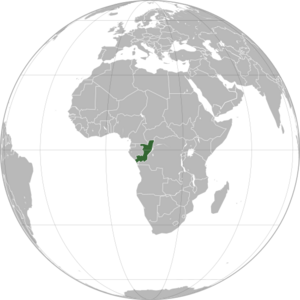
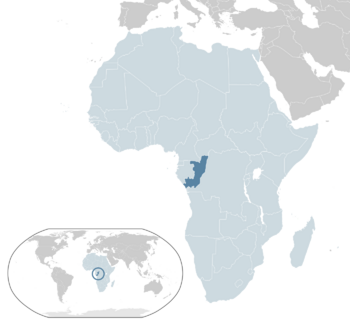
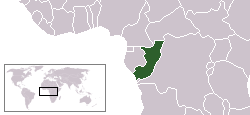
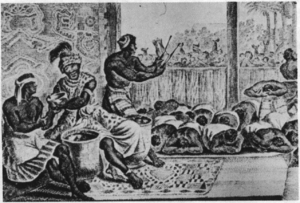
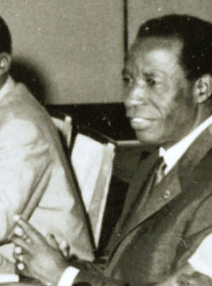
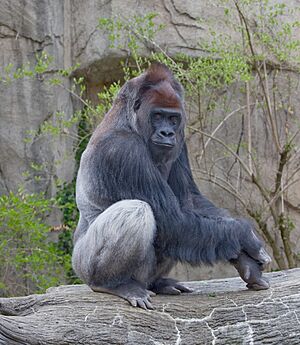



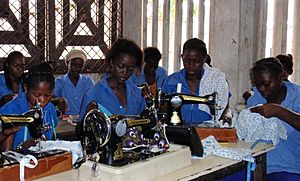

 In Spanish:
In Spanish: